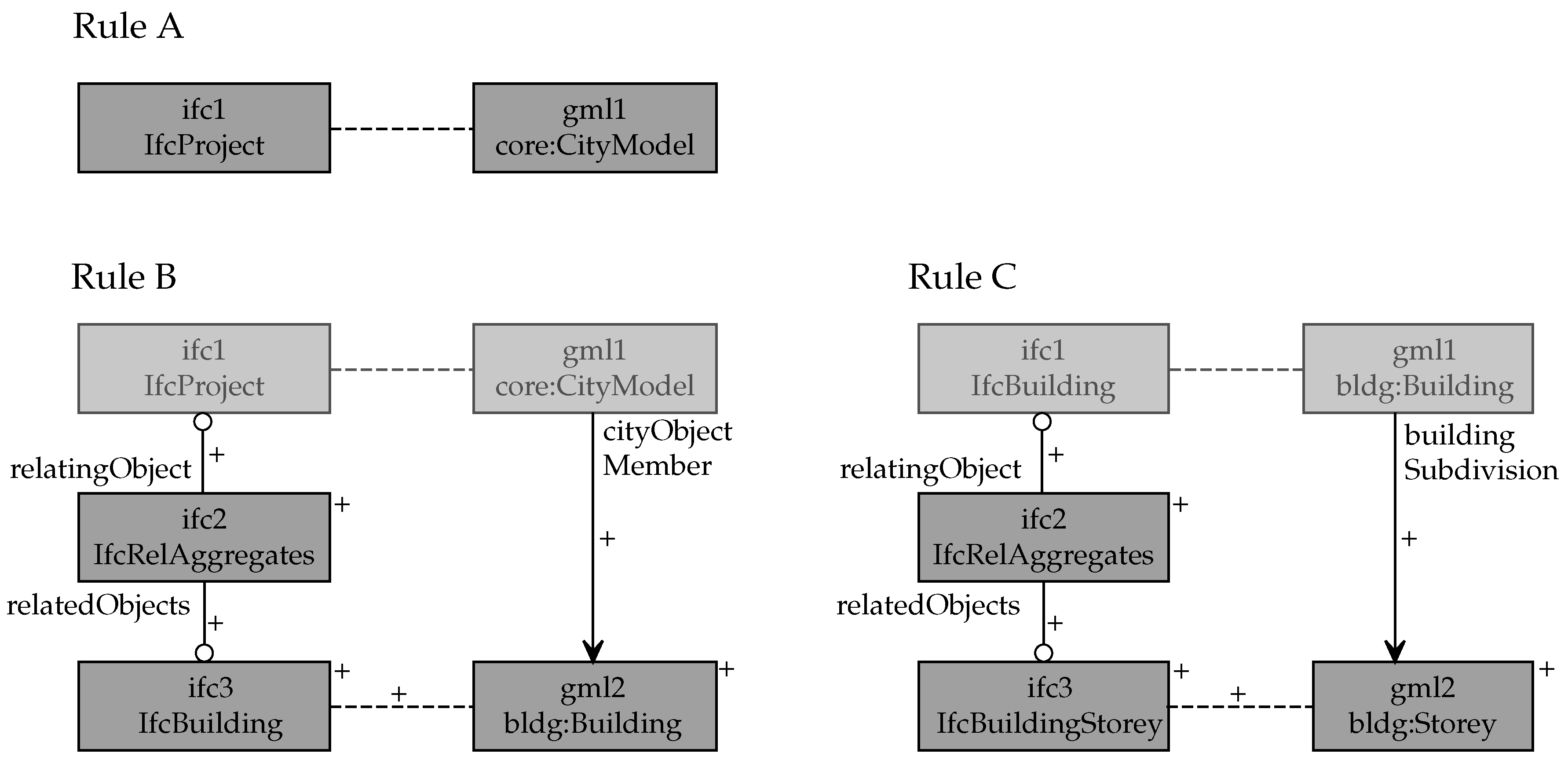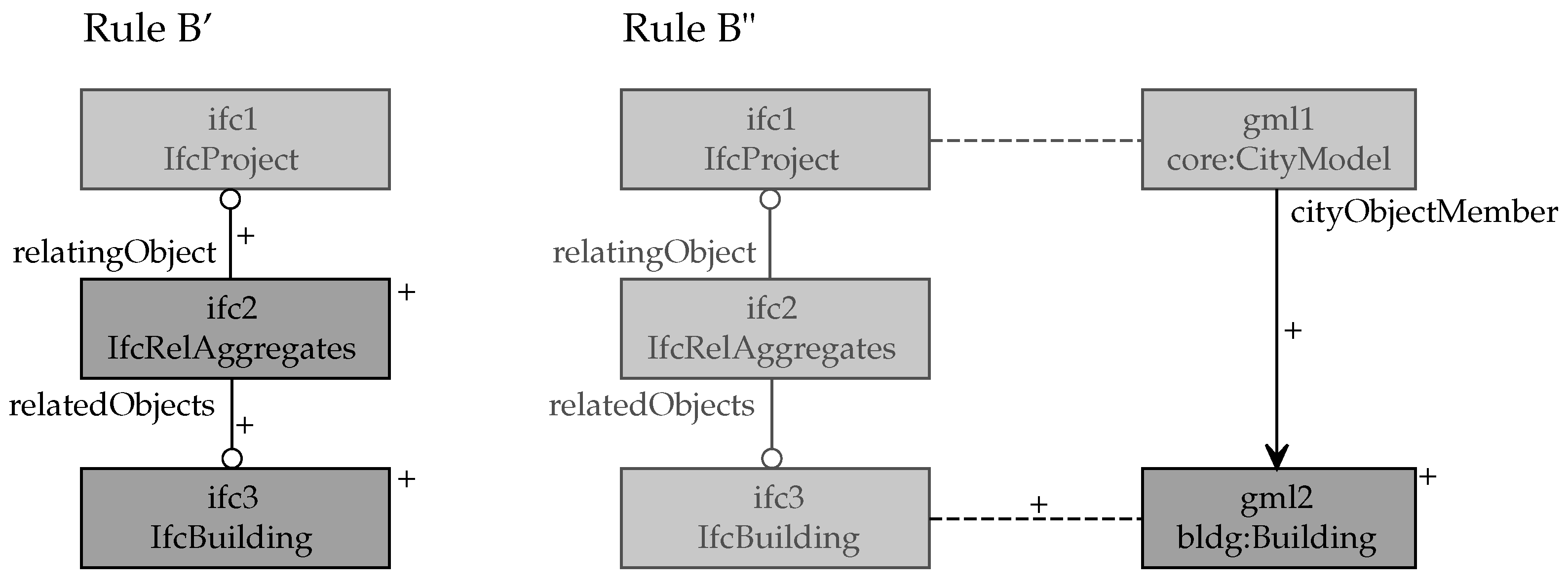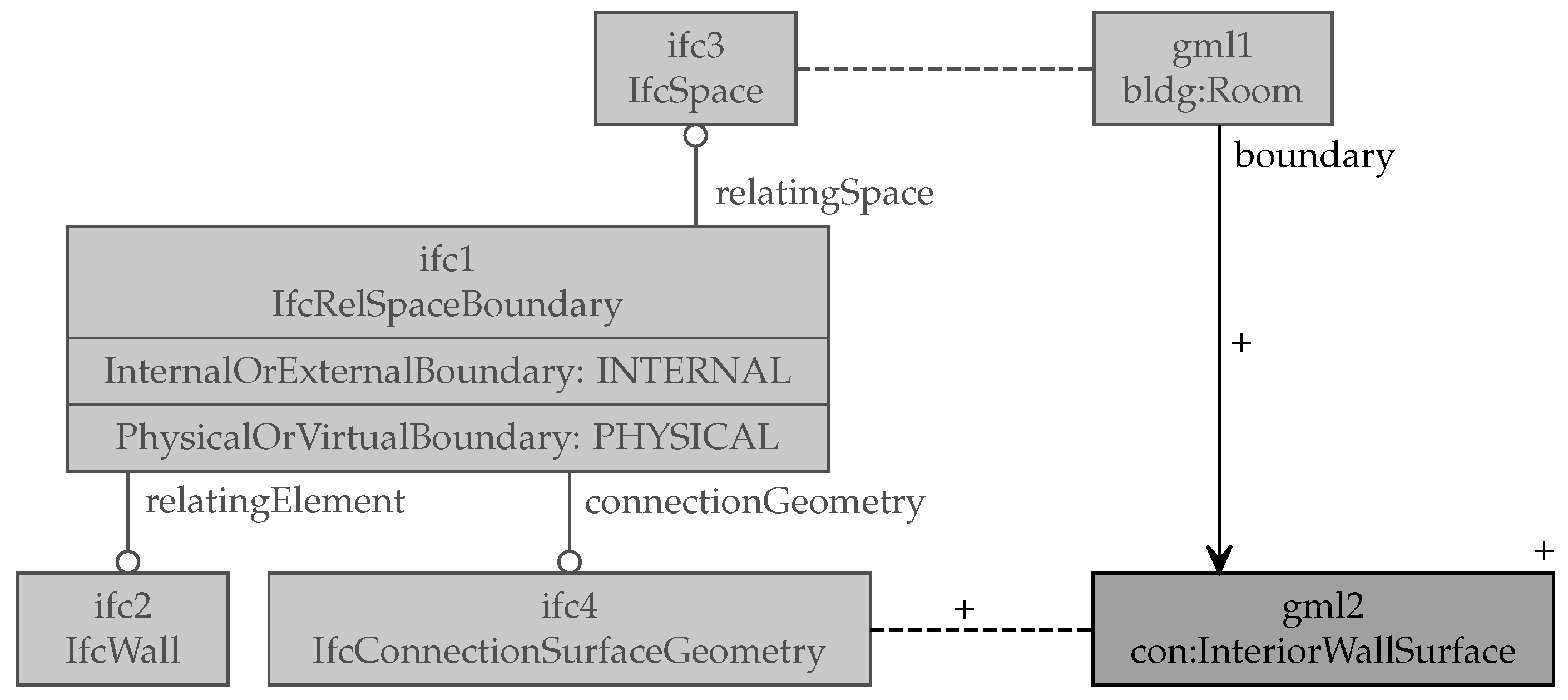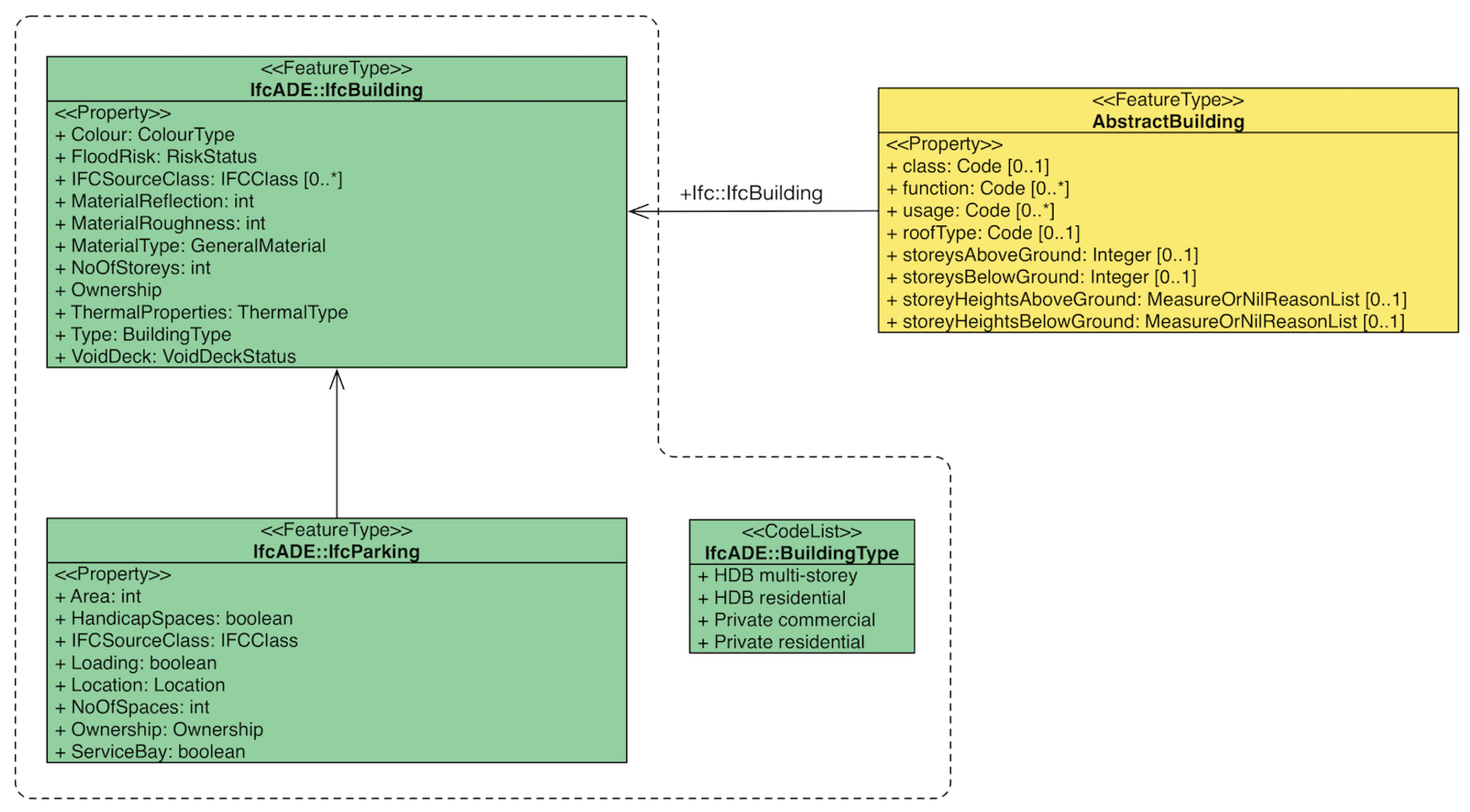Achieving Complete and Near-Lossless Conversion from IFC to CityGML †
Abstract
1. Introduction
2. State of the Art: IFC → CityGML Conversion
3. A Triple Graph Grammar Approach
3.1. TGG Introduction, Formal Concepts and Related Work
3.2. Application of the TGG Approach in Context of the IFC2CityGML Conversion
- The directed edges of the IFC graph have circle end marks, inspired by Express-G [40]. Note that Express-G is used to document the IFC schema and there is no dedicated graphical representation for instance graphs, thus we are using the schema notation.
- The directed edges of the CityGML graph have arrow end marks, same as associations in UML class and object diagrams [41].
- The undirected edges of the correlation graph are represented as dashed lines without arrow end marks.
- to transform a model of one type into the another,
- to compute the correspondence between two existing models, or
- to maintain the consistency between models of the respective types.
3.3. Direct Specification of Parsing and Transformation Rules for IFC → CityGML Conversion
- There are only two correlation graph edges, one in the set and one in the set .
- The edge connects nodes and .
- The edge connects nodes and .
- a path exists (taking edges as undirected) from to via edges in and nodes in .
- a path exists (taking edges as undirected) from to via edges in and nodes in .
3.4. Implementation of Rule-Based Conversion, Rule Set Specification and Application to Sample Data
3.5. Advantages and Limitations of the Approach
4. Development of an ADE
4.1. Overview and Related Work
4.2. Arguments for an ADE and Shortcomings
- It is the preferred method of extending the CityGML data model (the other one being the Generics mechanism, which allows generic attributes and objects, but is not without shortcomings [46]);
- Thanks to the flexible extension of the data model, ADE allows for a (in practice) nearly lossless and strict conversion from IFC to CityGML;
- ADE supports overcoming the lower structural level than IFC, enabling introduction of new concepts not available in CityGML; and
- ADE enables storing only the data we are interested in for particular use cases and stakeholders (i.e., it allows being “selectively strict and lossless”).
4.3. Towards an ADE for IFC within This Project
- Doing so from scratch developing a ”brand new” ADE.
- Modifying and/or extending an existing ADE (see for example the work of Kumar et al. [52] demonstrating that it is possible to customise an existing ADE to match particularities of a national context). Since ADEs are released as UML/XSD they can be further customised/extended and improved by others.
- Obsolescence: related work (such as the GeoBIM extension as one of the most prominent works in this field was published in 2011 [2]) might not be up-to-date anymore.
- Adapting to the Singapore context: development of a new ADE is not only beneficial to suit various geographical and architectural properties, but also to match properties of input IFC models that are specific to Singapore Government agencies.
- Fitting use cases: adaptation for use cases of interest to the project stakeholders. For example, the use case on planning vegetating roof surfaces (i.e., green roofs) would require information on the current status of the roofs.
- Identification of the relevant features and concepts to be translated from IFC to suit the geospatial context (see [2] for inspiration).
- Harmonisation with the local context (e.g., taking into account the local architecture and other aspects particular to a given geographic setting).
- Harmonisation with the national standardisation efforts (e.g., include attributes found in official standards).
- Identification of features relevant for a particular use case and stakeholder.
- Developing a single all-in ADE that is generic and applicable to a variety of use cases (similar to [2]).
- Developing custom (tailored) ADEs for each stakeholder that would focus on only one stakeholder and one use case at a time, e.g., one that suits the energy use case. This is not an entirely new idea, as some researchers develop such “mini-ADEs” or “light-ADEs” [54,55], which are specialised focusing on a narrow subject.
5. Discussion and Conclusions
Author Contributions
Funding
Acknowledgments
Conflicts of Interest
References
- Virtual Singapore. Available online: https://www.nrf.gov.sg/programmes/virtual-singapore (accessed on 26 March 2018).
- De Laat, R.; van Berlo, L. Integration of BIM and GIS: The Development of the CityGML GeoBIM Extension. In Advances in 3D Geo-Information Sciences; Springer: Berlin/Heidelberg, Germany, 2011; pp. 211–225. [Google Scholar]
- Deng, Y.; Cheng, J.C.P.; Anumba, C. Mapping between BIM and 3D GIS in different levels of detail using schema mediation and instance comparison. Autom. Constr. 2016, 67, 1–21. [Google Scholar] [CrossRef]
- Donkers, S.; Ledoux, H.; Zhao, J.; Stoter, J. Automatic conversion of IFC datasets to geometrically and semantically correct CityGML LOD3 buildings. Trans. GIS 2016, 20, 547–569. [Google Scholar] [CrossRef]
- Liu, X.; Wang, X.; Wright, G.; Cheng, J.; Li, X.; Liu, R. A State-of-the-Art Review on the Integration of Building Information Modeling (BIM) and Geographic Information System (GIS). ISPRS Int. J. Geo-Inf. 2017, 6, 53. [Google Scholar] [CrossRef]
- El-Mekawy, M.; Östman, A.; Hijazi, I. A Unified Building Model for 3D Urban GIS. ISPRS Int. J. Geo-Inf. 2012, 1, 120–145. [Google Scholar] [CrossRef]
- Daum, S.; Borrmann, A.; Kolbe, T. A Spatio-Semantic Query Language for the Integrated Analysis of City Models and Building Information Models. In Advances in 3D Geoinformation; Abdul-Rahman, A., Ed.; Springer International Publishing: Cham, Switzerland, 2017; pp. 79–93. [Google Scholar] [CrossRef]
- Arroyo Ohori, G.A.K.; Diakité, A.A.; Ledoux, H.; Stoter, J.; Krijnen, T. GeoBIM Project—Final Report; Technical Report; Delft University of Technology: Delft, The Netherlands, 2017. [Google Scholar]
- Benner, J.; Geiger, A.; Leinemann, K. Flexible generation of semantic 3D building models. In Proceedings of the 1st ISPRS/EuroSDR/DGPF International Workshop on Next Generation 3D City Models, Bonn, Germany, 21–22 June 2005; Gröger, G., Kolbe, T.H., Eds.; EuroSDR: Leuven, Belgium; pp. 17–22. [Google Scholar]
- Ellul, C.; Boyes, G.; Thomson, C.; Backes, D. Towards Integrating BIM and GIS—An End-to-End Example from Point Cloud to Analysis. In Advances in 3D Geoinformation; Springer: Cham, Switzerland, 2017; pp. 495–512. [Google Scholar]
- Geiger, A.; Benner, J.; Haefele, K.H. Generalization of 3D IFC Building Models. In 3D Geoinformation Science; Springer: Dubai, UAE, 2015; pp. 19–35. [Google Scholar]
- Kang, T.W.; Hong, C.H. A study on software architecture for effective BIM/GIS-based facility management data integration. Autom. Constr. 2015, 54, 25–38. [Google Scholar] [CrossRef]
- Hijazi, I.; Ehlers, M.; Zlatanova, S.; Becker, T.; van Berlo, L. Initial Investigations for Modeling Interior Utilities Within 3D Geo Context: Transforming IFC-Interior Utility to CityGML/UtilityNetworkADE. In Advances in 3D Geo-Information Sciences; Springer: Berlin/Heidelberg, Germany, 2011; pp. 95–113. [Google Scholar]
- Isikdag, U.; Zlatanova, S. Towards Defining a Framework for Automatic Generation of Buildings in CityGML Using Building Information Models. In 3D Geo-Information Sciences; Springer: Berlin/Heidelberg, Germany, 2009; pp. 79–96. [Google Scholar]
- Kang, T.W.; Hong, C.H. IFC-CityGML LOD mapping automation using multiprocessing-based screen-buffer scanning including mapping rule. KSCE J. Civ. Eng. 2017, 4, 1–11. [Google Scholar] [CrossRef]
- Jusuf, S.; Mousseau, B.; Godfroid, G.; Soh, J. Path to an Integrated Modelling between IFC and CityGML for Neighborhood Scale Modelling. Urban Sci. 2017, 1, 25. [Google Scholar] [CrossRef]
- Rafiee, A.; Dias, E.; Fruijtier, S.; Scholten, H. From BIM to Geo-analysis: View Coverage and Shadow Analysis by BIM/GIS Integration. Procedia Environ. Sci. 2014, 22, 397–402. [Google Scholar] [CrossRef]
- Sebastian, R.; Böhms, M.; van den Helm, P. BIM and GIS for low-disturbance construction. In Proceedings of the 13th International Conference on Construction Applications of Virtual Reality, London, UK, 30–31 October 2013; pp. 469–479. [Google Scholar]
- Teo, T.A.; Yu, S.C. The extraction of indoor building information from BIM to OGC IndoorGML. Int. Arch. Photogramm. Remote Sens. Spat. Inf. Sci. 2017, XLII-4/W2, 167–170. [Google Scholar] [CrossRef]
- Xu, X.; Ding, L.; Luo, H.; Ma, L. From building information modeling to city information modeling. J. Inf. Technol. Constr. ITcon 2014, 19, 292–307. [Google Scholar]
- Yu, S.C.; Teo, T.A. The generalization of BIM/IFC model for multi-scale 3D GIS/CityGML models. In Proceedings of the 35th Asian Conference on Remote Sensing, Nay Pyi Taw, Myanmar, 27–31 October 2014. [Google Scholar]
- Wu, B.; Zhang, S. Integration of GIS and BIM for indoor geovisual analytics. Int. Arch. Photogramm. Remote Sens. Spat. Inf. Sci. 2016, XLI-B2, 455–458. [Google Scholar] [CrossRef]
- Deng, Y.; Cheng, J.C.P.; Anumba, C. A framework for 3D traffic noise mapping using data from BIM and GIS integration. Struct. Infrastr. Eng. 2016, 12, 1267–1280. [Google Scholar] [CrossRef]
- Nagel, C.; Stadler, A.; Kolbe, T.H. Conceptual Requirements for the Automatic Reconstruction of Building Information Models from Uninterpreted 3D Models. In Academic Track of Geoweb 2009: Cityscapes; ISPRS: Berlin, Germany, 2009; Volume XXXVIII-3-4/C3. [Google Scholar]
- Cheng, J.C.; Deng, Y.; Anumba, C. Mapping BIM schema and 3D GIS schema semi-automatically utilizing linguistic and text mining techniques. J. Inf. Technol. Constr. 2015, 20, 193–212. [Google Scholar]
- Schürr, A. Specification of graph translators with triple graph grammars. In Graph-Theoretic Concepts in Computer Science; Springer: Berlin/Heidelberg, Germany, 1995; pp. 151–163. [Google Scholar] [CrossRef]
- Bardohl, R.; Ehrig, H.; de Lara, J.; Taentzer, G. Integrating Meta-modelling Aspects with Graph Transformation for Efficient Visual Language Definition and Model Manipulation. Procceedings of the Fundamental Approaches to Software Engineering (FASE), Barcelona, Spain, 29 March–2 April 2004; Wermelinger, M., Margaria-Steffen, T., Eds.; Springer: Berlin/Heidelberg, Germany, 2004; pp. 214–228. [Google Scholar]
- Westphal, M.; Rahm, T. Methoden zur automatischen Modelltransformation für die Simulation des maschinellen Tunnelvortriebs (Methods for the automatic model transformation for the simulation of mechanized tunneling operations). In Proceedings of the Forum Bauinformatik, Munich, Germany, 18–20 September 2013; pp. 135–146. [Google Scholar]
- Rahm, T. Simulation-Based Evaluation of Disturbances of Production and Logistic Processes in Mechanized Tunneling Operations. Ph.D. Thesis, Ruhr-Universität Bochum, Bochum, Germany, March 2017. [Google Scholar]
- Amelunxen, C.; Legros, E.; Schürr, A.; Stürmer, I. Checking and Enforcement of Modeling Guidelines with Graph Transformations. In Applications of Graph Transformations with Industrial Relevance; Schürr, A., Nagl, M., Zündorf, A., Eds.; Springer: Berlin/Heidelberg, Germany, 2008; pp. 313–328. [Google Scholar]
- Jakob, J.; Schürr, A. View Creation of Meta Models by Using Modified Triple Graph Grammars. Electron. Notes Theor. Comput. Sci. 2008, 211, 181–190. [Google Scholar] [CrossRef]
- Aschenbrenner, N.; Geiger, L. Transforming Scene Graphs Using Triple Graph Grammars: A Practice Report. In Applications of Graph Transformations with Industrial Relevance; Schürr, A., Nagl, M., Zündorf, A., Eds.; Springer: Berlin/Heidelberg, Germany, 2008; pp. 32–43. [Google Scholar]
- Ehrig, H.; Ehrig, K. Overview of Formal Concepts for Model Transformations Based on Typed Attributed Graph Transformation. Electron. Notes Theor. Comput. Sci. 2006, 152, 3–22. [Google Scholar] [CrossRef]
- Ehrig, H.; Ehrig, K.; Prange, U.; Taentzer, G. Fundamentals of Algebraic Graph Transformation. In Monographs in Theoretical Computer Science. An EATCS Series; Springer: Berlin, Germany, 2006. [Google Scholar] [CrossRef]
- Ehrig, H.; Ermel, C.; Golas, U.; Hermann, F. Model Transformation and Model Integration. In Graph and Model Transformation: General Framework and Applications; Springer: Berlin/Heidelberg, Germany, 2015; pp. 171–213. [Google Scholar]
- Czarnecki, K.; Helsen, S. Feature-based Survey of Model Transformation Approaches. IBM Syst. J. Model-Driv. Softw. Dev. 2006, 45, 621–645. [Google Scholar] [CrossRef]
- Taentzer, G.; Ehrig, K.; Guerra, E.; de Lara, J.; Lengyel, L.; Levendovszky, T.; Prange, U.; Varró, D.; Varro-Gyapay, S. Model Transformation by Graph Transformation: A Comparative Study. Available online: https://repositorio.uam.es/handle/10486/665862 (accessed on 20 May 2018).
- Greenyer, J.; Kindler, E. Reconciling TGGs with QVT. In Proceedings of the 10th International Conference on Model Driven Engineering Languages and Systems (MODELS’07), Nashville, TN, USA, 30 September–5 October 2007; Springer: Berlin/Heidelberg, Germany, 2007; pp. 16–30. [Google Scholar]
- Schürr, A.; Klar, F. 15 Years of Triple Graph Grammars: Research Challenges, New Contributions, Open Probelms. In Proceedings of the 4th International Conference on Graph Transformations (ICGT2008), Leicester, UK, 7–13 September 2008; Ehrig, H., Heckel, R., Rozenberg, G., Taentzer, G., Eds.; Springer: Berlin/Heidelberg, Germany, 2008; pp. 411–425. [Google Scholar]
- ISO. Industrial Automation Systems and Integration. Product Data Representation and Exchange. Part 11: Description Methods: The EXPRESS Language Reference Manual; International Standard ISO 10303-11; International Organization For Standardization: Geneva, Switzerland, 2004. [Google Scholar]
- ISO/IEC. Information Technology. Object Management Group Unified Modeling Language (OMG UML). Part 1: Infrastructure; International Standard ISO 19505-1; International Organization for Standardization: Geneva, Switzerland, 2012. [Google Scholar]
- Tauscher, H.; Crawford, J. Graph representations for querying, examination, and analysis of IFC data. In Proceedings of the 12th European Conference on Product and Process Modelling (ECPPM), Copenhagen Denmark, 12–14 September 2018. [Google Scholar]
- Lambers, L. A New Version of GTXL: An Exchange Format for Graph Transformation Systems. Electron. Notes Theor. Comput. Sci. 2005, 127, 51–63. [Google Scholar] [CrossRef]
- Kindler, E.; Wagner, R. Triple Graph Grammars: Concepts, Extensions, Implementations, and Application Scenarios. In Proceedings of the MODELS: International Conference on Model Driven Engineering Languages and Systems, Nashville, TN, USA, 30 September–5 October 2007. [Google Scholar]
- Konde, A.; Tauscher, H.; Biljecki, F.; Crawford, J. Floor plans in CityGML. ISPRS Ann. Photogramm. Remote Sens. Spat. Inf. Sci. 2018, in press. [Google Scholar]
- Biljecki, F.; Kumar, K.; Nagel, C. CityGML Application Domain Extension (ADE): Overview of developments. Open Geosp. Data Softw. Stand. 2018, 3, 13. [Google Scholar] [CrossRef]
- Open Geospatial Consortium. OGC City Geography Markup Language (CityGML) Encoding Standard 2.0.0; OGC Standard; Open Geospatial Consortium: Wayland, MA, USA, 2012. [Google Scholar]
- Agugiaro, G.; Benner, J.; Cipriano, P.; Nouvel, R. The Energy Application Domain Extension for CityGML: Enhancing interoperability for urban energy simulations. Open Geosp. Data Softw. Stand. 2018, 3, 139. [Google Scholar] [CrossRef]
- Biljecki, F.; Stoter, J.; Ledoux, H.; Zlatanova, S.; Çöltekin, A. Applications of 3D City Models: State of the Art Review. ISPRS Int. J. Geo-Inf. 2015, 4, 2842–2889. [Google Scholar] [CrossRef]
- Southall, R.; Biljecki, F. The VI-Suite: A set of environmental analysis tools with geospatial data applications. Open Geosp. Data Softw. Stand. 2017, 2, 23. [Google Scholar] [CrossRef]
- van den Brink, L.; Stoter, J.; Zlatanova, S. UML-Based Approach to Developing a CityGML Application Domain Extension. Trans. GIS 2013, 17, 920–942. [Google Scholar] [CrossRef]
- Kumar, K.; Ledoux, H.; Commandeur, T.J.F.; Stoter, J.E. Modelling urban noise in CityGML ADE: Case of the Netherlands. ISPRS Ann. Photogramm. Remote Sens. Spat. Inf. Sci. 2017, IV-4-W5, 73–81. [Google Scholar] [CrossRef]
- Löwner, M.O.; Gröger, G.; Benner, J.; Biljecki, F.; Nagel, C. Proposal for a new LOD and multi-representation concept for CityGML. ISPRS Ann. Photogramm. Remote Sens. Spat. Inf. Sci. 2016, IV-2/W1, 3–12. [Google Scholar]
- Egusquiza, A.; Prieto, I.; Romero, A. Multiscale information management for sustainable districts rehabilitation EFFESUS and FASUDIR projects. In Proceedings of the 10th European Conference on Product and Process Modelling (ECPPM), Vienna, Austria, 17–19 September 2014; pp. 303–308. [Google Scholar]
- Prieto, I.; Izkara, J.L.; del Hoyo, F.J.D. Efficient Visualization of the Geometric Information of CityGML: Application for the Documentation of Built Heritage. In Computational Science and Its Applications—ICCSA 2012; Springer: Berlin/Heidelberg, Germany, 2012; pp. 529–544. [Google Scholar]
- Karan, E.P.; Irizarry, J. Extending BIM interoperability to preconstruction operations using geospatial analyses and semantic web services. Autom. Constr. 2015, 53, 1–12. [Google Scholar] [CrossRef]








© 2018 by the authors. Licensee MDPI, Basel, Switzerland. This article is an open access article distributed under the terms and conditions of the Creative Commons Attribution (CC BY) license (http://creativecommons.org/licenses/by/4.0/).
Share and Cite
Stouffs, R.; Tauscher, H.; Biljecki, F. Achieving Complete and Near-Lossless Conversion from IFC to CityGML . ISPRS Int. J. Geo-Inf. 2018, 7, 355. https://doi.org/10.3390/ijgi7090355
Stouffs R, Tauscher H, Biljecki F. Achieving Complete and Near-Lossless Conversion from IFC to CityGML . ISPRS International Journal of Geo-Information. 2018; 7(9):355. https://doi.org/10.3390/ijgi7090355
Chicago/Turabian StyleStouffs, Rudi, Helga Tauscher, and Filip Biljecki. 2018. "Achieving Complete and Near-Lossless Conversion from IFC to CityGML " ISPRS International Journal of Geo-Information 7, no. 9: 355. https://doi.org/10.3390/ijgi7090355
APA StyleStouffs, R., Tauscher, H., & Biljecki, F. (2018). Achieving Complete and Near-Lossless Conversion from IFC to CityGML . ISPRS International Journal of Geo-Information, 7(9), 355. https://doi.org/10.3390/ijgi7090355





